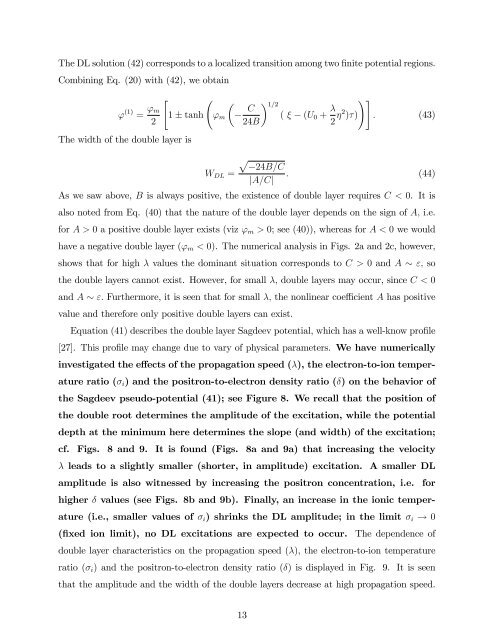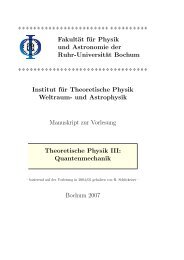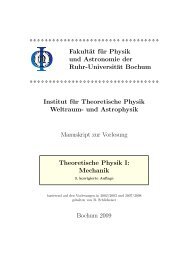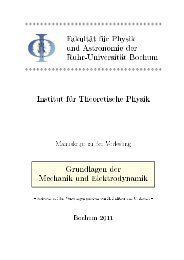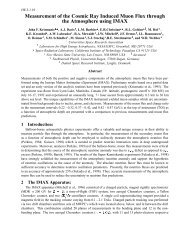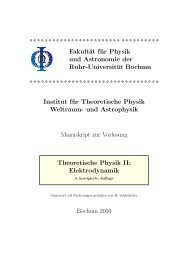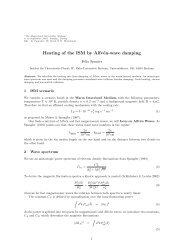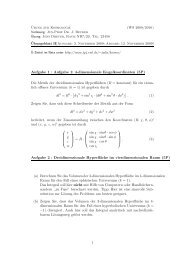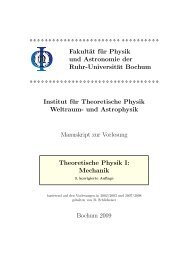pdf here - Theoretische Physik IV - Ruhr-Universität Bochum
pdf here - Theoretische Physik IV - Ruhr-Universität Bochum
pdf here - Theoretische Physik IV - Ruhr-Universität Bochum
You also want an ePaper? Increase the reach of your titles
YUMPU automatically turns print PDFs into web optimized ePapers that Google loves.
The DL solution (42) corresponds to a localized transition among two …nite potential regions.<br />
Combining Eq. (20) with (42), we obtain<br />
' (1) = ' m<br />
2<br />
The width of the double layer is<br />
"<br />
1=2 C<br />
1 tanh ' m ( (U 0 + ))!#<br />
<br />
24B<br />
2 2 : (43)<br />
W DL =<br />
p<br />
24B=C<br />
: (44)<br />
jA=Cj<br />
As we saw above, B is always positive, the existence of double layer requires C < 0. It is<br />
also noted from Eq. (40) that the nature of the double layer depends on the sign of A; i.e.<br />
for A > 0 a positive double layer exists (viz ' m > 0; see (40)), w<strong>here</strong>as for A < 0 we would<br />
have a negative double layer (' m < 0). The numerical analysis in Figs. 2a and 2c, however,<br />
shows that for high values the dominant situation corresponds to C > 0 and A "; so<br />
the double layers cannot exist. However, for small ; double layers may occur, since C < 0<br />
and A ": Furthermore, it is seen that for small ; the nonlinear coe¢ cient A has positive<br />
value and t<strong>here</strong>fore only positive double layers can exist.<br />
Equation (41) describes the double layer Sagdeev potential, which has a well-know pro…le<br />
[27]. This pro…le may change due to vary of physical parameters. We have numerically<br />
investigated the e¤ects of the propagation speed (), the electron-to-ion temperature<br />
ratio ( i ) and the positron-to-electron density ratio () on the behavior of<br />
the Sagdeev pseudo-potential (41); see Figure 8. We recall that the position of<br />
the double root determines the amplitude of the excitation, while the potential<br />
depth at the minimum <strong>here</strong> determines the slope (and width) of the excitation;<br />
cf. Figs. 8 and 9. It is found (Figs. 8a and 9a) that increasing the velocity<br />
leads to a slightly smaller (shorter, in amplitude) excitation. A smaller DL<br />
amplitude is also witnessed by increasing the positron concentration, i.e.<br />
higher values (see Figs. 8b and 9b). Finally, an increase in the ionic temperature<br />
(i.e., smaller values of i ) shrinks the DL amplitude; in the limit i ! 0<br />
(…xed ion limit), no DL excitations are expected to occur.<br />
for<br />
The dependence of<br />
double layer characteristics on the propagation speed (), the electron-to-ion temperature<br />
ratio ( i ) and the positron-to-electron density ratio () is displayed in Fig. 9. It is seen<br />
that the amplitude and the width of the double layers decrease at high propagation speed.<br />
13


